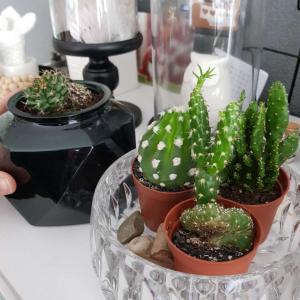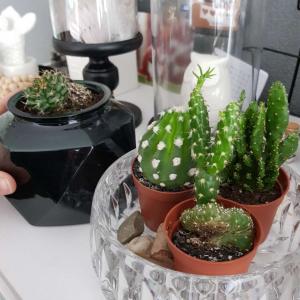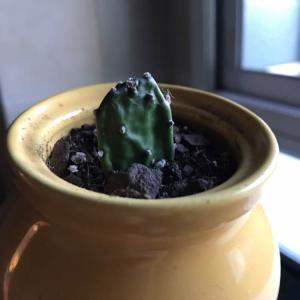文章
Miss Chen
2017年09月19日

Este cactus americano crece exclusivamente en Argentina y Chile, es por tanto endémico de dichos paises. Su nombre científico se construye a partir de la palabra “maihuén” que es la voz mapuche con que se designa a la planta y de la palabra “patagonica” por su origen geográfico. El hábitat natural de esta especie se encuentra en la región de la Patagonia, situada al sur de Argentina y Chile.
Es un cactus de hasta 40 cm de altura, sus tallos son alargados y estrechos, 2 cm de anchura. Las hojas son carnosas y de unos 6 mm de longitud. Las espinas son blancas en la base y pueden tomar una coloración rojiza, verdosa o grisácea en el ápice. Las flores son grandes para el tamaño del cactus, 5,5 cm de diámetro, y por lo general son de color blanco, rosa pálido o ligeramente azulado. Aparecen en el extemo superior de los tallos y lo hacen en a finales de la primavera o principio del verano.

La Maihuenia patagonica es una planta muy fácil de cultivar. Se puede cultivar en una rocalla por ejemplo siempre que en invierno no haga demasiado frío. La temperatura promedio más baja que puede soportar es de unos 10ºC. También podemos cultivarla en interior siempre que cuente con buena iluminación y no tenga que sufrir temperaturas demasiado altas por la calefacción. Hay que tener en cuenta que es una especie de cactus que crece en zonas altas, alrededor de los 2500 metros de altura y no soporta bien las temperaturas muy altas.

Por el mismo motivo debe disfrutar de una muy buena ventilación. En la temporada de crecimiento la fertilizaremos con un abono rico en potasio y fósforo pero pobre en nitrógeno. Debe recibir al menos algunas horas de sol directo cada día. La regaremos cuando el sustrato esté bien seco.

En primavera, cuando hay mucha diferencia de temperatura entre el día y la noche, es proclive a sufrir enfermedades fúngicas. Enfermedades que trataremos con algún fungicida sistémico. Cada 2-3 años transplantaremos nuestra Maihuenia patagonica a una maceta más grande.
Es un cactus de hasta 40 cm de altura, sus tallos son alargados y estrechos, 2 cm de anchura. Las hojas son carnosas y de unos 6 mm de longitud. Las espinas son blancas en la base y pueden tomar una coloración rojiza, verdosa o grisácea en el ápice. Las flores son grandes para el tamaño del cactus, 5,5 cm de diámetro, y por lo general son de color blanco, rosa pálido o ligeramente azulado. Aparecen en el extemo superior de los tallos y lo hacen en a finales de la primavera o principio del verano.

La Maihuenia patagonica es una planta muy fácil de cultivar. Se puede cultivar en una rocalla por ejemplo siempre que en invierno no haga demasiado frío. La temperatura promedio más baja que puede soportar es de unos 10ºC. También podemos cultivarla en interior siempre que cuente con buena iluminación y no tenga que sufrir temperaturas demasiado altas por la calefacción. Hay que tener en cuenta que es una especie de cactus que crece en zonas altas, alrededor de los 2500 metros de altura y no soporta bien las temperaturas muy altas.

Por el mismo motivo debe disfrutar de una muy buena ventilación. En la temporada de crecimiento la fertilizaremos con un abono rico en potasio y fósforo pero pobre en nitrógeno. Debe recibir al menos algunas horas de sol directo cada día. La regaremos cuando el sustrato esté bien seco.

En primavera, cuando hay mucha diferencia de temperatura entre el día y la noche, es proclive a sufrir enfermedades fúngicas. Enfermedades que trataremos con algún fungicida sistémico. Cada 2-3 años transplantaremos nuestra Maihuenia patagonica a una maceta más grande.
0
0
文章
Dummer. ゛☀
2017年09月19日

Cacti are easy-care houseplants because their feeding and watering needs are extremely low. You can largely ignore them and they still thrive. But if you’re a chronic overwaterer, cacti may be a source of endless frustration. When your cactus has clearly been overwatered, don’t fear — there is a chance you can save it. If there is no fungal or bacterial rot present, a change of neighborhoods may be enough to get your cactus back on track.
Damage Assessment
If you suspect overwatering and damage, such as soft brown spots, are obvious on the outside of the cactus, unpot the plant by wrapping a few layers of newspaper around it and tipping the cactus out. Carefully brush the soil from the roots and check them for brown or black areas. Extensive damage may be difficult to fix, but if most of the roots are still white, you’re in good shape. Cut away the black and brown roots and leave the cactus out of its pot to dry. If brown or black rot areas are extensive, you will need to reroot the cactus. A cactus that has only been occasionally overwatered will recover without further drama.
Encourage Drainage
When overwatering is a chronic problem, help the cactus to shed as much water as quickly as possible in the future. Select an unglazed clay pot only slightly bigger than the cactus and fill it with a commercial cactus mix. Pot the cactus in the mix gently, so you don’t upset its delicate roots. The clay pot will wick away more water from the root zone while the loose cactus mix allows water to drain quickly and completely. You should only plant very large landscape cacti directly in the ground because landscape plantings give you less control over drainage.
Rerooting
When roots or tissues are extensively damaged from overwatering, use a sharp, clean knife to cut away all the rot from the cactus. Even a small portion of healthy tissue can regenerate a whole plant, but if you leave the rot behind, it may continue to spread. Allow the cactus to dry on the counter for several days until a thick scab forms on the cut sections. Place the remaining cactus section into a clay pot with cactus soil and bury it about 1 inch (2.5 cm) deep unless there isn’t much of the cactus left — in that case, bury it about halfway. Don’t water the cactus for the first week, and only water sparingly after that until new growth appears.
Proper Watering
Once your cactus is repotted and ready for success, correct watering is vital to prevent new problems. Only water cacti when the top 1 to 2 inches (2.5 to 5 cm) of the soil — depending on the size of the cactus — is completely dry. Do not water the plant from the bottom and never leave it sitting in a saucer of water. It is much better for cacti to be dry than to be wet — a good rule of thumb is to water about once every 10 days.

Damage Assessment
If you suspect overwatering and damage, such as soft brown spots, are obvious on the outside of the cactus, unpot the plant by wrapping a few layers of newspaper around it and tipping the cactus out. Carefully brush the soil from the roots and check them for brown or black areas. Extensive damage may be difficult to fix, but if most of the roots are still white, you’re in good shape. Cut away the black and brown roots and leave the cactus out of its pot to dry. If brown or black rot areas are extensive, you will need to reroot the cactus. A cactus that has only been occasionally overwatered will recover without further drama.

Encourage Drainage
When overwatering is a chronic problem, help the cactus to shed as much water as quickly as possible in the future. Select an unglazed clay pot only slightly bigger than the cactus and fill it with a commercial cactus mix. Pot the cactus in the mix gently, so you don’t upset its delicate roots. The clay pot will wick away more water from the root zone while the loose cactus mix allows water to drain quickly and completely. You should only plant very large landscape cacti directly in the ground because landscape plantings give you less control over drainage.

Rerooting
When roots or tissues are extensively damaged from overwatering, use a sharp, clean knife to cut away all the rot from the cactus. Even a small portion of healthy tissue can regenerate a whole plant, but if you leave the rot behind, it may continue to spread. Allow the cactus to dry on the counter for several days until a thick scab forms on the cut sections. Place the remaining cactus section into a clay pot with cactus soil and bury it about 1 inch (2.5 cm) deep unless there isn’t much of the cactus left — in that case, bury it about halfway. Don’t water the cactus for the first week, and only water sparingly after that until new growth appears.

Proper Watering
Once your cactus is repotted and ready for success, correct watering is vital to prevent new problems. Only water cacti when the top 1 to 2 inches (2.5 to 5 cm) of the soil — depending on the size of the cactus — is completely dry. Do not water the plant from the bottom and never leave it sitting in a saucer of water. It is much better for cacti to be dry than to be wet — a good rule of thumb is to water about once every 10 days.
0
0
文章
Dummer. ゛☀
2017年09月19日

Christmas Cactus is a hardy tropical cactus that brightens the environment with gorgeous, red and pink blooms around the winter holidays. Although Christmas Cactus is easy to get along with and requires minimal care, it is susceptible to root rot. Usually, this dreaded fungal disease is not caused by inattention, but is the result of improper watering.
Signs of Root Rot
A Christmas Cactus with root rot displays wilted, limp, sagging growth, but an inspection of the roots will tell the tale.
Remove the plant gently from its pot. If the cactus is affected by rot, the roots will display blackened tips. Depending on the severity of the disease, rotten Christmas Cactus roots will be slimy with black or brown decay.
If you determine that your Christmas Cactus is rotting, it’s critical to act fast. Rot is a deadly disease and once it progresses, the only option is to discard the plant and start fresh. If part of the plant is healthy, you can use a leaf to propagate a new plant.
Treatment
If you catch the disease early, you may be able to save it. Remove the Christmas Cactus from the container immediately. Trim away affected roots and rinse the remaining roots gently to remove fungus. Place the plant on a paper towel and put it in a warm, well-ventilated location so the roots can dry overnight.
Place the Christmas Cactus in a dry pot with fresh, lightweight potting soil the next day. Be sure the pot has a drainage hole so the soil can drain freely. Wait a couple of days before watering the newly potted Christmas Cactus.
Prevention
When you resume watering, be sure you understand the most effective way to irrigate your Christmas Cactus. Always water thoroughly until water drips through the drainage hole, then let the plant drain before returning the pot to its drainage saucer. Never let the plant stand in water.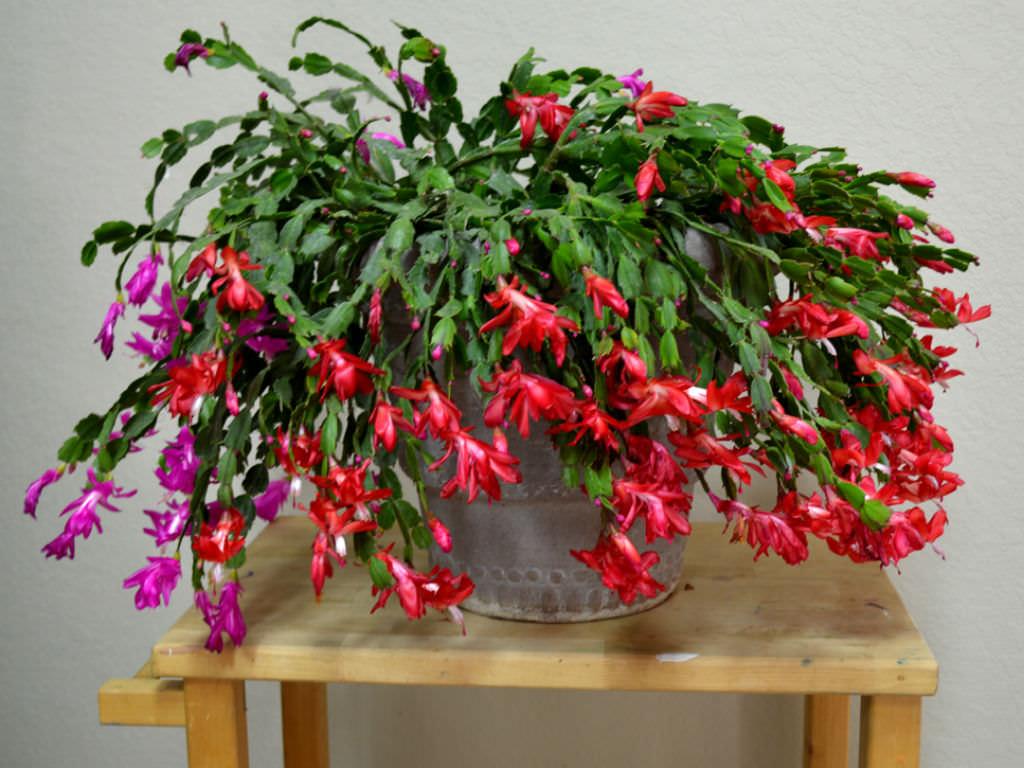
Be careful not to kill the plant with kindness; slightly underwatered conditions are healthiest. Don’t water until the top 0.5 inch (1.2 cm) of soil feels dry. Water sparingly during the winter months, but don’t allow the potting mix to become bone dry. Place the plant in bright sunlight during fall and winter and in light shade during spring and summer.

Signs of Root Rot
A Christmas Cactus with root rot displays wilted, limp, sagging growth, but an inspection of the roots will tell the tale.
Remove the plant gently from its pot. If the cactus is affected by rot, the roots will display blackened tips. Depending on the severity of the disease, rotten Christmas Cactus roots will be slimy with black or brown decay.

If you determine that your Christmas Cactus is rotting, it’s critical to act fast. Rot is a deadly disease and once it progresses, the only option is to discard the plant and start fresh. If part of the plant is healthy, you can use a leaf to propagate a new plant.
Treatment
If you catch the disease early, you may be able to save it. Remove the Christmas Cactus from the container immediately. Trim away affected roots and rinse the remaining roots gently to remove fungus. Place the plant on a paper towel and put it in a warm, well-ventilated location so the roots can dry overnight.

Place the Christmas Cactus in a dry pot with fresh, lightweight potting soil the next day. Be sure the pot has a drainage hole so the soil can drain freely. Wait a couple of days before watering the newly potted Christmas Cactus.
Prevention
When you resume watering, be sure you understand the most effective way to irrigate your Christmas Cactus. Always water thoroughly until water drips through the drainage hole, then let the plant drain before returning the pot to its drainage saucer. Never let the plant stand in water.

Be careful not to kill the plant with kindness; slightly underwatered conditions are healthiest. Don’t water until the top 0.5 inch (1.2 cm) of soil feels dry. Water sparingly during the winter months, but don’t allow the potting mix to become bone dry. Place the plant in bright sunlight during fall and winter and in light shade during spring and summer.
2
0
文章
Dummer. ゛☀
2017年09月19日

Cacti are remarkably durable and low in maintenance. The succulents need little more than sun, well drained soil and rare moisture. The pests and problems common to the plant group are minimal and usually easy to surmount. Cactus problems may range from sucking pests, like whitefly, to common rots from bacteria or fungal disease. One of the telltale signs of a problem is a soft, mushy cactus.
The arid gardener may ask, “Why is my cactus going soft?” Likely causes are disease, cultivation and improper site and ambient conditions.
Cacti generally have low moisture needs. They thrive in temperatures above 70 to 75 °F (21 to 24 °C) in sunny locations and require little supplemental nutrients. Potted plants need good drainage holes and a soil mix with plenty of grit. In-ground plants have similar requirements.
As with any plant, cacti can become diseased or damaged. A common problem is soft spots in the flesh of the plant. These may be discolored or corky around the spot and the center is mushy and wet. The reasons for such spots may be disease or simply mechanical injury to the pads and stems of the cacti. Cactus rot issues must be dealt with quickly to prevent spread to the rest of the plant and serious loss of vigor, which may become permanent.
Problems with Fungal and Bacterial Diseases
Bacteria and fungus are introduced to the plant from openings in the flesh. The open areas may be from insect or animal activity, damage from inanimate objects or heavy weather, such as hail. The action of injury isn’t important, but the damage from fungal spores or bacteria is crucial.
Warm, moist conditions accelerate the production of fungi spores and increase bacterial production. Once the organism takes hold in your plant, you will see soft, mushy cactus. Symptoms to watch for include small sunken spots, discolored scabs, round soft areas surrounded by fruiting bodies, and black or other colored dots on the surface of the cacti skin. You may even notice some oozing of your cactus plants.
Treating
Cactus problems that have gotten into the root usually result in a slowly dying plant, while topical issues in the upper body can be treated easily. Most cacti respond well to excising the diseased tissue. Use a sharp sterile knife to dig out the damaged flesh and allow the hole to dry out. Don’t water overhead as the wound closes.
If the damage has infected the roots, there is very little you can do. You can try to repot the plant, removing diseased soil and replacing it with sterile soil. You should wash the roots off well before replanting in fresh potting medium.
A soft, mushy cactus can also be saved by taking cuttings and letting them root for a fresh new plant. Allow the cutting to callus over for a few days before you insert it into sand. Rooting the cutting may take several weeks. This method of propagation will produce a healthy cactus that is the same as the parent plant.

The arid gardener may ask, “Why is my cactus going soft?” Likely causes are disease, cultivation and improper site and ambient conditions.
Cacti generally have low moisture needs. They thrive in temperatures above 70 to 75 °F (21 to 24 °C) in sunny locations and require little supplemental nutrients. Potted plants need good drainage holes and a soil mix with plenty of grit. In-ground plants have similar requirements.

As with any plant, cacti can become diseased or damaged. A common problem is soft spots in the flesh of the plant. These may be discolored or corky around the spot and the center is mushy and wet. The reasons for such spots may be disease or simply mechanical injury to the pads and stems of the cacti. Cactus rot issues must be dealt with quickly to prevent spread to the rest of the plant and serious loss of vigor, which may become permanent.
Problems with Fungal and Bacterial Diseases
Bacteria and fungus are introduced to the plant from openings in the flesh. The open areas may be from insect or animal activity, damage from inanimate objects or heavy weather, such as hail. The action of injury isn’t important, but the damage from fungal spores or bacteria is crucial.
Warm, moist conditions accelerate the production of fungi spores and increase bacterial production. Once the organism takes hold in your plant, you will see soft, mushy cactus. Symptoms to watch for include small sunken spots, discolored scabs, round soft areas surrounded by fruiting bodies, and black or other colored dots on the surface of the cacti skin. You may even notice some oozing of your cactus plants.

Treating
Cactus problems that have gotten into the root usually result in a slowly dying plant, while topical issues in the upper body can be treated easily. Most cacti respond well to excising the diseased tissue. Use a sharp sterile knife to dig out the damaged flesh and allow the hole to dry out. Don’t water overhead as the wound closes.
If the damage has infected the roots, there is very little you can do. You can try to repot the plant, removing diseased soil and replacing it with sterile soil. You should wash the roots off well before replanting in fresh potting medium.

A soft, mushy cactus can also be saved by taking cuttings and letting them root for a fresh new plant. Allow the cutting to callus over for a few days before you insert it into sand. Rooting the cutting may take several weeks. This method of propagation will produce a healthy cactus that is the same as the parent plant.
0
0
文章
Dummer. ゛☀
2017年09月18日

Every year about this time, stores of all sorts sell something called “Christmas Cactus”, a showy plant with segmented foliage that arches out over the sides of the pot. Since most people find the foliage relatively unimpressive, the seasonal specials are always sold in bud or with newly-opened blooms. The long, tubular flowers, which appear at the ends of the stems, are made up of many slender, pointed petals fused at the bases. Flower colors range from white through shades of peach, orange, purple, rose and red, with bi-colored varieties widely available.

Sometimes merchants trying for early sales offer the similar-looking “Thanksgiving Cactus” starting just after Halloween. To the casual buyer, these are dead ringers for Christmas Cactus and also bear a close resemblance to the “Easter Cactus” sold in the spring. To make matters just a little more complicated, the various holiday cacti are all sometimes sold under the exotic-sounding name “Zygocactus”.

So what is up with all of these holiday cacti? Is it all marketing or are they different plants? More to the point, if you are seduced by those showy blossoms, will your Thanksgiving/Christmas/Easter cactus survive for more than a few weeks? Southerners, especially older ones, will sometimes tell tales of family Christmas Cacti that have survived for generations. Are they talking about the same plants that now grace thousands of big box stores?
Even reference sources differ on the specifics of holiday cactus nomenclature. The experts at Clemson University identify Thanksgiving Cactus as a single species, Schlumbergera truncata, Christmas Cactus as Schlumbergera bridgesii and the closely related Easter Cactus as Hatiora gaertneri. English botanist Martyn Rix identifies Christmas Cactus as a hybrid, Schlumbergera x buckleyi, originally created in the 1840’s by a man named Buckley who crossed Schlumbergera truncata with Schlumbergera russelliana to create the progenitors of the modern hybrid Christmas cactus.

What does all this mean? For the average person—absolutely nothing. Those who have nurtured ancestral Christmas Cacti for decades can rest assured that their holiday plants are essentially the same as the specimens that today’s urban sophisticates buy in funky shops to decorate their minimalist apartments. All holiday cacti are very similar, except for bloom times. They are native to areas of Brazil near Rio de Janeiro, where they live as epiphytes, non-parasitic plants that flourish in trees, deriving sustenance from air, water and debris that collect around them. This is good news for those of us who love them, as they don’t need the bright sunlight required by terrestrial cacti. They also do not have the sharp spines of some of their relatives in the true cactus or Cactaceae family.

The vast majority of holiday cacti are sold growing in soil-like potting mix. What they really need is excellent drainage, not to mention caretakers who refrain from flooding them with water every day. Overwatering—which means watering before the soil is dry to the touch—can result in potentially fatal rot. If your holiday cactus is not thriving, cut back on water and repot it in a mixture of about 40 percent perlite—available at garden centers—and 60 percent fresh potting mix. Those who hate repotting plants can take comfort in the knowledge that holiday cacti bloom best when they are slightly pot-bound and only need repotting every three or four years.

All holiday cacti should come in before nighttime temperatures begin falling below 50 degrees Fahrenheit (10 degrees Celsius). Sometimes, if the plant undergoes dramatic temperature changes, flower buds will drop off. There is not much to be done, other than avoiding extremes the next time. Fertilize with a balanced, water-soluble houseplant fertilizer diluted to half strength. Stop fertilizing in late summer to encourage flower formation in Christmas and Thanksgiving cacti. Resume about a month after the flowers have bloomed.

Sometimes merchants trying for early sales offer the similar-looking “Thanksgiving Cactus” starting just after Halloween. To the casual buyer, these are dead ringers for Christmas Cactus and also bear a close resemblance to the “Easter Cactus” sold in the spring. To make matters just a little more complicated, the various holiday cacti are all sometimes sold under the exotic-sounding name “Zygocactus”.

So what is up with all of these holiday cacti? Is it all marketing or are they different plants? More to the point, if you are seduced by those showy blossoms, will your Thanksgiving/Christmas/Easter cactus survive for more than a few weeks? Southerners, especially older ones, will sometimes tell tales of family Christmas Cacti that have survived for generations. Are they talking about the same plants that now grace thousands of big box stores?
Even reference sources differ on the specifics of holiday cactus nomenclature. The experts at Clemson University identify Thanksgiving Cactus as a single species, Schlumbergera truncata, Christmas Cactus as Schlumbergera bridgesii and the closely related Easter Cactus as Hatiora gaertneri. English botanist Martyn Rix identifies Christmas Cactus as a hybrid, Schlumbergera x buckleyi, originally created in the 1840’s by a man named Buckley who crossed Schlumbergera truncata with Schlumbergera russelliana to create the progenitors of the modern hybrid Christmas cactus.

What does all this mean? For the average person—absolutely nothing. Those who have nurtured ancestral Christmas Cacti for decades can rest assured that their holiday plants are essentially the same as the specimens that today’s urban sophisticates buy in funky shops to decorate their minimalist apartments. All holiday cacti are very similar, except for bloom times. They are native to areas of Brazil near Rio de Janeiro, where they live as epiphytes, non-parasitic plants that flourish in trees, deriving sustenance from air, water and debris that collect around them. This is good news for those of us who love them, as they don’t need the bright sunlight required by terrestrial cacti. They also do not have the sharp spines of some of their relatives in the true cactus or Cactaceae family.

The vast majority of holiday cacti are sold growing in soil-like potting mix. What they really need is excellent drainage, not to mention caretakers who refrain from flooding them with water every day. Overwatering—which means watering before the soil is dry to the touch—can result in potentially fatal rot. If your holiday cactus is not thriving, cut back on water and repot it in a mixture of about 40 percent perlite—available at garden centers—and 60 percent fresh potting mix. Those who hate repotting plants can take comfort in the knowledge that holiday cacti bloom best when they are slightly pot-bound and only need repotting every three or four years.

All holiday cacti should come in before nighttime temperatures begin falling below 50 degrees Fahrenheit (10 degrees Celsius). Sometimes, if the plant undergoes dramatic temperature changes, flower buds will drop off. There is not much to be done, other than avoiding extremes the next time. Fertilize with a balanced, water-soluble houseplant fertilizer diluted to half strength. Stop fertilizing in late summer to encourage flower formation in Christmas and Thanksgiving cacti. Resume about a month after the flowers have bloomed.
0
0
文章
Dummer. ゛☀
2017年09月18日

Cacti are flowering plants, so every kind of cactus is capable of blooming when it is mature. Whether or not an individual cactus plant blooms depends on its age and the care it gets. Some cacti don’t bloom until they are more than 30 years old. Others won’t bloom, even if they are old enough, unless they get proper light conditions, watering and fertilization. This is especially true for potted cacti. Holiday Cacti grown indoors, such as Christmas Cactus, won’t bloom unless they get long nights and short days.

Columnar Cacti
Tall-growing columnar cacti often take years before they bloom for the first time if grown from seed. If you root a branch from a mature, already-blooming columnar cactus, it will keep blooming after it is separated from the mother plant and rooted. However, some cacti, such as Saguaro (Carnegiea gigantea), native to Arizona in U.S. Department of Agriculture plant hardiness zones 9 through 11, have branches that won’t root, so Saguaro has to be grown from seed, with a 40- to 55-year wait for the first flower. Some columnar cacti that produce flowers for the first time after 10 to 20 years and can live outdoors in USDA zones 9 through 11 are Peruvian Apple (Cereus repandus) with blue stems and large white night-blooming flowers, Senita Cactus (Pachycereus schottii) with gray-green stems and small pink flowers produced amid an area of dense shaggy spines, and Mexican Fence Post (Pachycereus marginatus) with bright green stems that have white-defined stem ridges and smaller white flowers. Columnar cacti are effective landscaping plants even without flowers.

Short-stem Cacti
Short-columnar cacti with mature stems below 2 feet (60 cm) tall usually flower within five years from germination. Hedgehog Cacti (Echinocereus spp.) are native to the United States and Mexico, and make mounding clumps of many stems over time. Large pink, magenta or red flowers are abundant in spring. Depending on the species, Hedgehog Cactus grows in USDA zones 5, for red-flowered short claret cup (Echinocereus coccineus), through 11. Easter Lily Cactus (Echinopsis oxygona and hybrids) are hardy in USDA zones 8 through 11. They produce huge funnel-shaped flowers in white, pink, lavender, magenta or red. For the size of the plant, Peanut Cactus (Echinopsis chamaecereus) produces large flowers. Stems up to 6 inches (15 cm) long, covered with weak white spines, crawl along the ground and produce abundant bright orange flowers over 1 inch (2.5 cm) wide in spring. Peanut Cactus grows outdoors in USDA zones 8 through 11.

Round Cacti
Some of the most floriferous cacti belong here, such as Pincushion Cacti (Mammillaria spp. and hybrids) and Rebutias (Rebutia spp. and hybrids). They usually bloom within three to four years after sprouting. Pincushion Cacti are native to the United States and Mexico, producing star-shaped flowers in a ring around the top of the stem. Although round when young, some elongate to small columns. Flowers are white, pink, magenta, lavender, red, yellow or green, and plants grow outdoors in USDA zones 8 through 10. Rebutias are native to South America. Tidy low-growing plants cluster with age, and red, yellow, orange or purple flowers come from near the base of the stem. Rebutias are hardy in USDA zones 9 through 11.

Conditions that Encourage Bloom
Since cacti grow as container plants in any USDA zone, give them proper care and they will reward you with blossoms. Most cacti need at least four hours of sunlight a day, preferably morning sunlight. Water them regularly during the growing season, allowing the top inch or two of soil to dry before watering again until water comes through the pot’s drainage holes. Don’t let water remain in pot saucers. Use well-draining soilless potting mix. Fertilize them monthly from when they begin spring growth to the end of summer with a half-strength low-nitrogen high-phosphorus formula, which promotes bloom. Allow the cactus to become somewhat pot-bound for best bloom. Decrease watering in winter, and give your cacti a winter dormancy period with lower temperatures (50°F/10°C).

Holiday Cacti
Thanksgiving Cactus (Schlumbergera truncata) and Christmas Cactus (Schlumbergera bridgesii) look so different than desert cacti that some people are surprised that they are cacti. They look different because they grow on Brazilian rain forest trees as epiphytes, and their stems are flattened and green, looking leaf-like. They need different care than desert cacti. Holiday Cacti are triggered to bloom in fall and winter by cooling temperatures, increasing night length and decreasing day length with only 8 to 10 hours of light. Most of the year they prefer partial shade, but in fall and winter they can be in sunlight.

Columnar Cacti
Tall-growing columnar cacti often take years before they bloom for the first time if grown from seed. If you root a branch from a mature, already-blooming columnar cactus, it will keep blooming after it is separated from the mother plant and rooted. However, some cacti, such as Saguaro (Carnegiea gigantea), native to Arizona in U.S. Department of Agriculture plant hardiness zones 9 through 11, have branches that won’t root, so Saguaro has to be grown from seed, with a 40- to 55-year wait for the first flower. Some columnar cacti that produce flowers for the first time after 10 to 20 years and can live outdoors in USDA zones 9 through 11 are Peruvian Apple (Cereus repandus) with blue stems and large white night-blooming flowers, Senita Cactus (Pachycereus schottii) with gray-green stems and small pink flowers produced amid an area of dense shaggy spines, and Mexican Fence Post (Pachycereus marginatus) with bright green stems that have white-defined stem ridges and smaller white flowers. Columnar cacti are effective landscaping plants even without flowers.

Short-stem Cacti
Short-columnar cacti with mature stems below 2 feet (60 cm) tall usually flower within five years from germination. Hedgehog Cacti (Echinocereus spp.) are native to the United States and Mexico, and make mounding clumps of many stems over time. Large pink, magenta or red flowers are abundant in spring. Depending on the species, Hedgehog Cactus grows in USDA zones 5, for red-flowered short claret cup (Echinocereus coccineus), through 11. Easter Lily Cactus (Echinopsis oxygona and hybrids) are hardy in USDA zones 8 through 11. They produce huge funnel-shaped flowers in white, pink, lavender, magenta or red. For the size of the plant, Peanut Cactus (Echinopsis chamaecereus) produces large flowers. Stems up to 6 inches (15 cm) long, covered with weak white spines, crawl along the ground and produce abundant bright orange flowers over 1 inch (2.5 cm) wide in spring. Peanut Cactus grows outdoors in USDA zones 8 through 11.

Round Cacti
Some of the most floriferous cacti belong here, such as Pincushion Cacti (Mammillaria spp. and hybrids) and Rebutias (Rebutia spp. and hybrids). They usually bloom within three to four years after sprouting. Pincushion Cacti are native to the United States and Mexico, producing star-shaped flowers in a ring around the top of the stem. Although round when young, some elongate to small columns. Flowers are white, pink, magenta, lavender, red, yellow or green, and plants grow outdoors in USDA zones 8 through 10. Rebutias are native to South America. Tidy low-growing plants cluster with age, and red, yellow, orange or purple flowers come from near the base of the stem. Rebutias are hardy in USDA zones 9 through 11.

Conditions that Encourage Bloom
Since cacti grow as container plants in any USDA zone, give them proper care and they will reward you with blossoms. Most cacti need at least four hours of sunlight a day, preferably morning sunlight. Water them regularly during the growing season, allowing the top inch or two of soil to dry before watering again until water comes through the pot’s drainage holes. Don’t let water remain in pot saucers. Use well-draining soilless potting mix. Fertilize them monthly from when they begin spring growth to the end of summer with a half-strength low-nitrogen high-phosphorus formula, which promotes bloom. Allow the cactus to become somewhat pot-bound for best bloom. Decrease watering in winter, and give your cacti a winter dormancy period with lower temperatures (50°F/10°C).

Holiday Cacti
Thanksgiving Cactus (Schlumbergera truncata) and Christmas Cactus (Schlumbergera bridgesii) look so different than desert cacti that some people are surprised that they are cacti. They look different because they grow on Brazilian rain forest trees as epiphytes, and their stems are flattened and green, looking leaf-like. They need different care than desert cacti. Holiday Cacti are triggered to bloom in fall and winter by cooling temperatures, increasing night length and decreasing day length with only 8 to 10 hours of light. Most of the year they prefer partial shade, but in fall and winter they can be in sunlight.
1
1
成长记
cclecombe
2017年09月18日

I new added a "Cactus" in my "garden"


1
0
meriunkat:Mamillaria is one of her names
文章
Dummer. ゛☀
2017年09月17日

Maihuenia is a genus largely accepted as containing two species which are quite distinct from other cactus. The plants in this genus are so different that they have been classified as the sole genus in the subfamily Maihuenioideae.

These plants grow as mats which hug the ground and are made up of segmented short-rounded stems. The stems feature typically 3 spines per areole and also have small rounded leaves which do not fall off as they do in Opuntias. The flowers come from the ends of the stems and are shades of yellow from near-white to orange. Club-shaped fruits are fleshy and contain bracts.
The natural habitat of this species is in the region known as Patagonia in the southern parts of Argentina and Chile at elevations of 8,000 feet (2450 m) elevation. In this harsh environment, these cacti commonly endure frost and are starting to become sought by cold-hardy cactus growers in North America.

Growing Condition and General Care
Maihuenia is an easy-to-grow plant. It can survive outside in the garden in the sunny rockery on a sheltered place, but only if it’s protected with a sheet of glass during the wintertime. It is also very good for a large pot which can be stored inside an unheated greenhouse or on a balcony, somewhat protected from moisture during the winter, but is probably safest to grow it in the Alpine House or in a raised bed inside an unheated greenhouse all year around, with lots of ventilation. They should not be kept hot in summer as they are from high elevations.
During the growing season it’s good to enrich the soil using a fertilizer rich in potassium and phosphorous, but poor in nitrogen.
For a balanced development, it is best to place it in a position where it is exposed at least a few hours of direct sunlight.
Water these plants only from time to time if grown outdoors, but it should be watered abundantly if grown in a pot or in the greenhouse, during the summer.
The spring weather, with a high temperature swing between the day and night hours, and pretty frequent rains, can favor the development of fungus diseases, which should be treated with a systemic fungicide. Repot it every 2 to 3 years.

These plants grow as mats which hug the ground and are made up of segmented short-rounded stems. The stems feature typically 3 spines per areole and also have small rounded leaves which do not fall off as they do in Opuntias. The flowers come from the ends of the stems and are shades of yellow from near-white to orange. Club-shaped fruits are fleshy and contain bracts.
The natural habitat of this species is in the region known as Patagonia in the southern parts of Argentina and Chile at elevations of 8,000 feet (2450 m) elevation. In this harsh environment, these cacti commonly endure frost and are starting to become sought by cold-hardy cactus growers in North America.

Growing Condition and General Care
Maihuenia is an easy-to-grow plant. It can survive outside in the garden in the sunny rockery on a sheltered place, but only if it’s protected with a sheet of glass during the wintertime. It is also very good for a large pot which can be stored inside an unheated greenhouse or on a balcony, somewhat protected from moisture during the winter, but is probably safest to grow it in the Alpine House or in a raised bed inside an unheated greenhouse all year around, with lots of ventilation. They should not be kept hot in summer as they are from high elevations.
During the growing season it’s good to enrich the soil using a fertilizer rich in potassium and phosphorous, but poor in nitrogen.
For a balanced development, it is best to place it in a position where it is exposed at least a few hours of direct sunlight.
Water these plants only from time to time if grown outdoors, but it should be watered abundantly if grown in a pot or in the greenhouse, during the summer.

The spring weather, with a high temperature swing between the day and night hours, and pretty frequent rains, can favor the development of fungus diseases, which should be treated with a systemic fungicide. Repot it every 2 to 3 years.
0
0
求助
Nicole Rebecca Vincent
2017年09月13日

Identification??
I think this may be "old lady cactus" but I'm unsure.
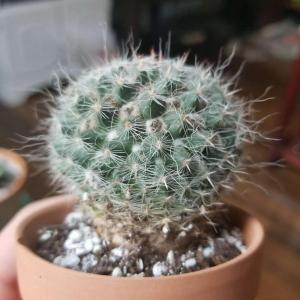
I think this may be "old lady cactus" but I'm unsure.

0
0
求助
twunklink
2017年09月10日

can i have some help IDing these succulents and a (maybe) baby cactus in this pot i picked up? thanks!!
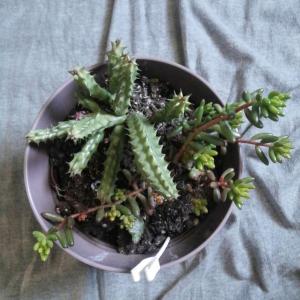
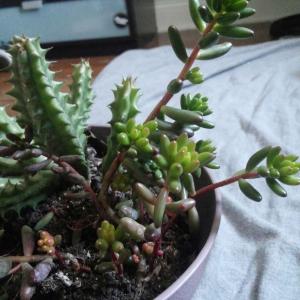
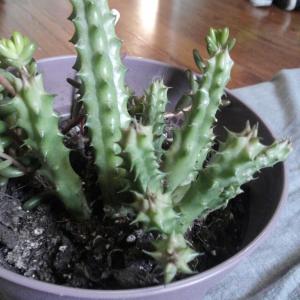
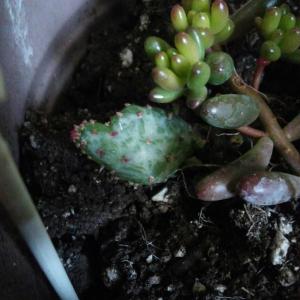




0
0
Ueca:Brown plant with stems is Sedum rubrotinctum.



